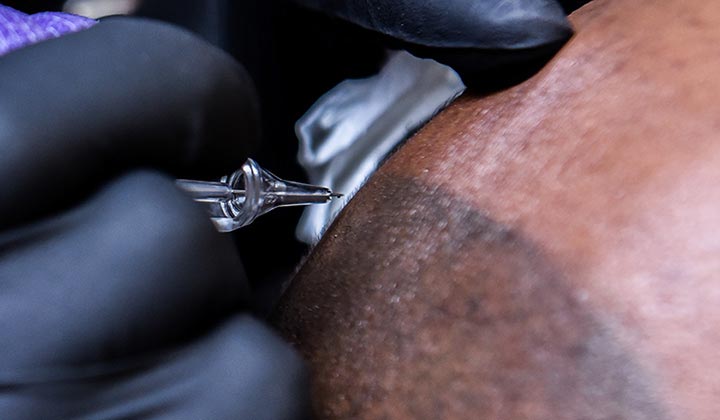Scalp micropigmentation, also known as a hair tattoo, can cover bald spots or thinning hair without surgery. Providers use thin needles to deposit tiny dots of pigment (color) on the scalp. This treatment can cover bald spots or create a shaved head look.
Advertisement
Cleveland Clinic is a non-profit academic medical center. Advertising on our site helps support our mission. We do not endorse non-Cleveland Clinic products or services. Policy

Scalp micropigmentation is a cosmetic treatment for thinning hair or hair loss. It’s sometimes also called a hair tattoo. A provider uses thin, small needles to deposit tiny dots of pigment (color) on the scalp. These dots give the appearance of thicker hair. Scalp micropigmentation pigments are cosmetic-grade, permanent inks.
Advertisement
Cleveland Clinic is a non-profit academic medical center. Advertising on our site helps support our mission. We do not endorse non-Cleveland Clinic products or services. Policy
When a skilled technician performs scalp micropigmentation, it can hide thinning areas on your scalp. It may also hide birthmarks or scars. The treatment can also give the illusion of having shaved hair or a “buzz cut” on people who are bald. Scalp micropigmentation is noninvasive and doesn’t require surgery or anesthesia.
Scalp micropigmentation is a type of micropigmentation (permanent makeup). The treatment can create the appearance of thicker hair in people who have:
Scalp micropigmentation doesn’t grow hair or change your natural hair growth. It’s not a hair loss treatment. It also won’t cause hair loss or damage your existing hair follicles. Scalp micropigmentation is a way to make it look like you have fuller, thicker hair.
Before scalp micropigmentation:
Advertisement
Your provider uses a needle to deposit medical-grade pigment on the desired areas of the scalp. The dots vary in size, angle and depth to provide a natural, hairlike appearance.
Your treatment may take up to five hours, depending on the size of the treatment area. Most people need three or more treatments, spaced several weeks apart. Each treatment adds more pigment to create the look of thick hair.
Since there’s no surgery or anesthesia, you can go back to daily life quickly. There are very few side effects of scalp micropigmentation. You may have some redness on your scalp that lasts several hours. You can wear a hat or scarf to cover the scalp if you want.
The benefits of scalp micropigmentation compared to hair transplantation surgery include:
The biggest risks of scalp micropigmentation come with using an unlicensed or inexperienced practitioner who may not take the necessary precautions.
Possible risks include:
To avoid these risks:
People who are prone to keloids (scars that grow larger than normal) should not get scalp micropigmentation. The treatment can cause keloids to form in some people.
After the treatment, you may need to avoid certain activities for several days, including:
Scalp micropigmentation usually retains its appearance for four years or longer. The pigments used in scalp micropigmentation are permanent cosmetic pigments. They are not the same as tattoo ink, so they resist fading or color change.
Call your healthcare provider if you notice possible signs of infection after scalp micropigmentation, such as:
Once you’ve chosen a licensed and experienced micropigmentation specialist, ask them:
Advertisement
No. Scalp micropigmentation and permanent makeup are elective (optional) procedures. Ask your provider about the cost of the procedure and how many treatments you will need.
When performed by a skilled provider, many people are satisfied with the results of scalp micropigmentation. Because the pigments last several years, scalp micropigmentation is low-maintenance and long-lasting.
Hair loss or thinning doesn’t have to interfere with your self-confidence. People experience hair loss for many reasons, either due to conditions such as alopecia, male pattern baldness or hormonal conditions. Or perhaps you have a scar or birthmark you want to cover. Scalp micropigmentation is an effective, noninvasive way to make your hair look thicker.
Advertisement
Last reviewed on 04/14/2022.
Learn more about the Health Library and our editorial process.